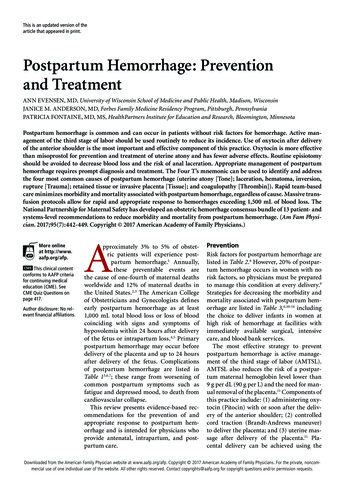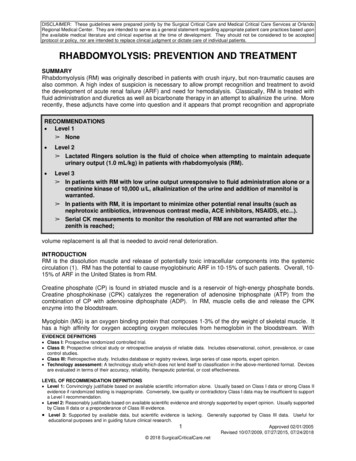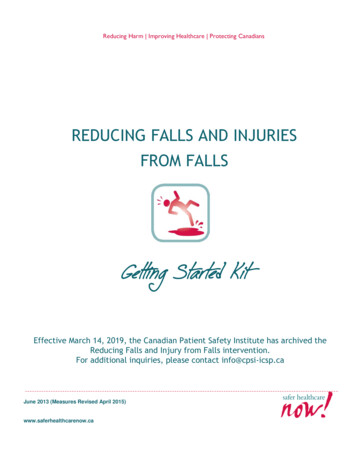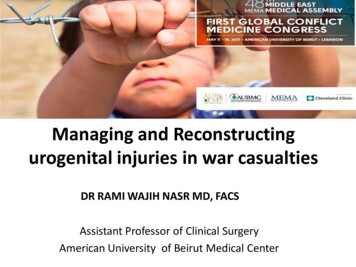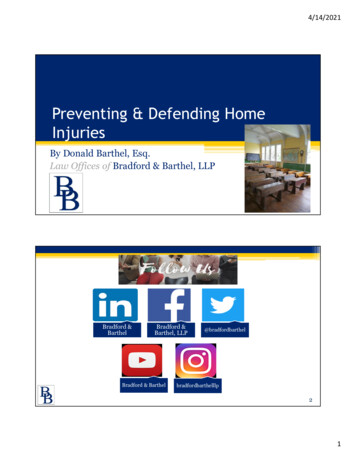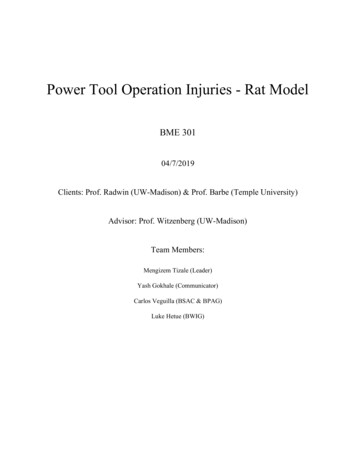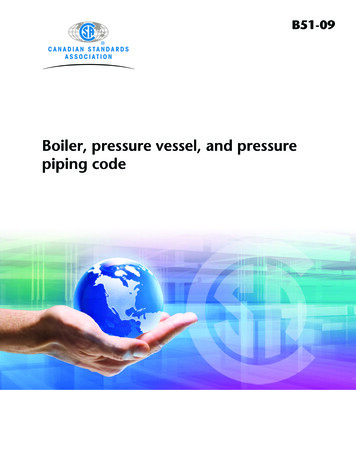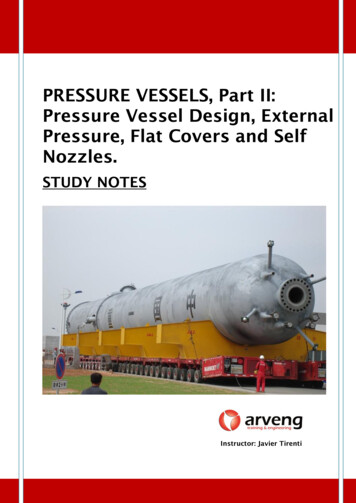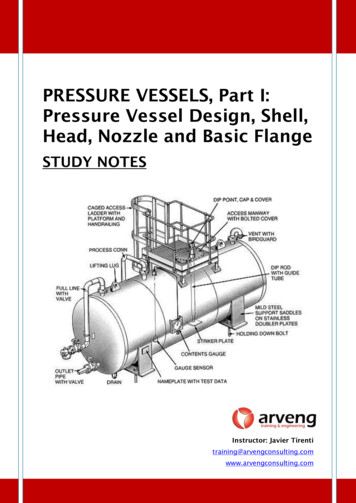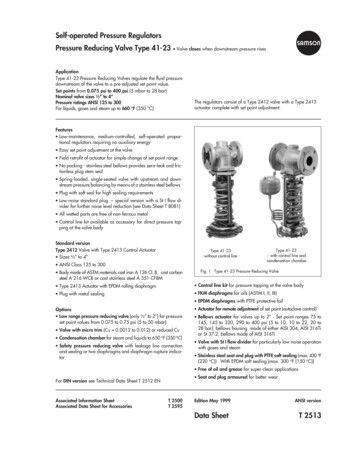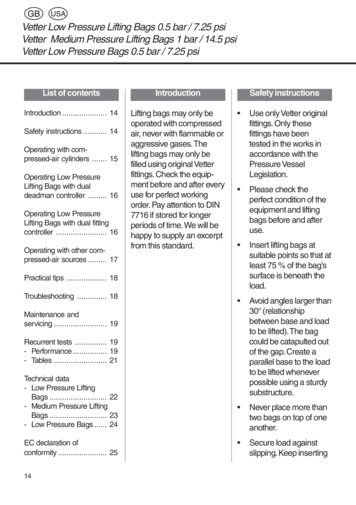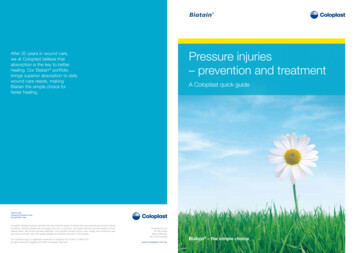
Transcription
Pressure injuries – prevention and treatmentAfter 30 years in wound care,we at Coloplast believe thatabsorption is the key to betterhealing. Our Biatain portfoliobrings superior absorption to dailywound care needs, makingBiatain the simple choice forfaster healing.Coloplast develops products and services that make life easier for people with very personal and private medicalconditions. Working closely with the people who use our products, we create solutions that are sensitive to theirspecial needs. We call this intimate healthcare. Our business includes ostomy care, urology and continence careand wound and skin care. We operate globally and employ more than 7,000 people.The Coloplast logo is a registered trademark of Coloplast A/S. 2013-10 WOU197.All rights reserved Coloplast A/S, 3050 Humlebæk, Denmark.A Coloplast quick guideColoplast Pty Ltd33 Gilby RoadMount WaverleyVIC 3149 Australiawww.coloplast.com.auBiatain – the simple choice
Table of ContentsPressure injuries– prevention and treatmentPressure injuries – prevention and treatment. 3What is a pressure injury?. 4How do pressure injuries arise?. 5Who gets pressure injuries?. 6Prevalence of pressure injuries. 7Risk factors. 8The Braden scale for predicting pressure injury risk. 9Prevention of pressure injuries. 10Prevention protocols by risk level. 11International NPUAP-EPUAPPressure injury classification system. 12Treatment of pressure injuries. 15Dressing selection. 16Wound infection. 18Case study. 20Coloplast solutions for pressure injuries. 22Biatain – superior absorption for faster healing. 25Other Coloplast products for pressure injuries. 26References. 27Although the quality of pressure injury prevention and treatmenthas increased considerably over the past years, pressure injuriesremain a frequently occurring problem in health care. Especiallyold people and people that are confined to chair or bed ares usceptible to pressure injuries. In recent years, new internationalguidelines have been published.This quick guide is intended for educational and informationalpurposes only. It contains some of the most important advice forprevention and treatment of pressure injuries and will be helpfulto health care professionals who are not dealing with pressureinjuries every day.Please note that in this quick guide we have described only verygeneral guidelines. For a full description of the optimal treatmentof pressure injuries at the different stages, please refer to yournational guidelines and to the ‘Pressure injury treatment – Quickreference guide’ published by the NPUAP-EPUAP in 2009 (www.epuap.org).For more extensive guidance on prevention of pressure injuries,please refer to ‘Pressure injury prevention – Quick reference guide’published by the NPUAP-EPUAP in 2010 (www.epuap.org).Good advice and useful tools for pressure injury prevention arealso available at the Braden-homepage (www.braden.com)Coloplast A/S, March 2012.34
What is a pressure injury?How do pressureinjuries arise?International NPUAP-EPUAP pressure injury definition:A pressure injury is defined as a degenerative change caused bybiological tissue (skin and underlying tissue) being exposed topressure and shearing forces. The pressure prevents the bloodfrom circulating properly and causes cell death, tissue necrosisand the development of injuries.A pressure injury (decubitus ulcer) is alocalised injury to the skin and/or underlyingtissue usually over a bony prominence andis the result of pressure, or pressure incombination with shear.1Pressure injuries are a major cause of morbidity and mortality, especially for persons with impaired sensation, prolonged immobility or advanced age.NPUAP copyright & used withpermissionNPUAP copyright & used withpermissionThe effect of compressive forces and shear forces on tissuesand blood supplyNPUAP copyright & used withpermission5NPUAP copyright & used withpermissionWithout loadCompressiveforcesShear forces6
Who getspressure injuries?Prevalence ofpressure injuriesDespite current interest and advances in medicine, surgery,nursing care and self-care education, pressure injuries remain amajor cause of morbidity and mortality. This is particularly true forpersons with impaired sensation, prolonged immobility, oradvanced age.2National prevalence studies have been conducted in severalcountries. Recently, 5947 patients were surveyed in 25 hospitalsin five European countries. The pressure injury prevalence (Stage1–4) was 18.1%, if Stage 1 injuries were excluded it was 10.5%.The sacrum and heels were the most affected locations. Only9.7% of the patients in need of prevention received fullyadequate preventive care.4 Also, prevalence surveys in U.S.,among patients in acute care hospitals, indicated a pressureinjury prevalence ranging from 10.1% to 17%.4People aged over 75 are more prone to developing pressureinjuries.3 However, because people and skin age at differentrates, younger patients can also have frail skin. If somebody withfrail skin remains in one position for too long without shifting theirweight, they are at risk of pressure injuries. Wheelchair users orpeople confined to a bed (for example, after surgery or an injury),are especially at risk.The most common places for pressure injuries are over a bonyprominence, such as elbows, heels, hips, ankles, shoulders,back and the back of the head.7Vertebrae, NPUAP copyright &used with permissionIschium, NPUAP copyright &used with permissionAnkle, NPUAP copyright &used with permissionHeel, NPUAP copyright &used with permission8
Risk factorsThe Braden scalefor predictingpressure injury riskThe following factors increase the risk for pressure injuries3,5· Being bed or chair bound· Old age ( 75 years)· Unable to move body or parts of body without help· Chronic conditions, such as diabetes or vascular disease, whichaffect blood circulation· Mental disability from conditions such as Alzheimer’s disease· Fragile skin· Urinary and bowel incontinence· MalnourishmentThe Braden scale is a clinically validated tool that allows nursesand other healthcare providers to reliably score a person’s levelof risk for developing pressure injuries by examining six criteria:In their international pressure injury prevention guidelines theNPUAP & EPUAP recommend to use a structured approach torisk assessment to identify individuals at risk of developingpressure injuries.1 One of the most widely used risk assessmenttools worldwide is the Braden Scale for Predicting Pressure SoreRisk , developed by Barbara Braden and Nancy Bergstrom in1988.7 Therefore the Braden scale will be used as an example ofa risk assessment tool in the following chapters.· Sensory Perception – ability to respond meaningfully to pressure-related discomfort (1–4)· Moisture – degree to which skin is exposed to moisture (1–4)· Activity – degree of physical activity (1–4)· Mobility – ability to change and control body position (1–4)· Nutrition – usual food intake pattern (1–4)· Friction and Shear – amount of assistance needed to move, degree of sliding on beds or chairs (1–3)The lowest possible total score is 6 and the highest is 23. Thelower score, the higher risk of developing pressure injuries. Peoplewith scores of 15-18 are at risk of developing pressure injuries ifother major risk factors are present. People with scores of 9 andbelow are at very high risk of developing pressure injuries.7-9The Braden scale should always be used in conjunction withnursing judgment. Each subscale score serves as a flag forassessments that need to be explored further and a guide to thetypes of interventions that may be required. The lower the subscale scores and total scores, the more ‘intense’ the nursinginterventions should become.6An official copy of the Braden scale can be downloaded : these are general guidelines. There may be specific pressure injury screening systems at use in your country or at your work place,which must be followed.910
Prevention ofpressure injuriesPrevention protocolsby risk levelA person that is bed bound or cannot move due to paralysis,diabetes, circulation problems, incontinence, or mentaldisabilities, should be frequently checked for pressure injuries.Special attention should be paid to the areas over a bonyprominence where pressure injuries often form.The cornerstone of pressure injury prevention is identifying andminimizing risk factors with the use of a validated risk assessmenttool. If you use the Braden scale there is a protocol that can bereferred to for each risk level:5Look for reddened areas that, when pressed, do not turn white,and for blisters, sores, or craters.In addition, take the following steps5,9· Change the patient’s position no less than every 2 hours torelieve pressure, for example, by using a turning schedule· Use items that can help reduce pressure: pressure-reducingpillows, foam padding, pressure reducing mattresses etc.· Meals must contain the required amount of calories and proteins· Provide adequate vitamins and minerals· Provide and encourage adequate daily fluid intake for hydration· Daily exercise· Keep the skin clean and dry· After urinating or having a bowel movement, clean the areaand dry it well. Use creams to help protect the skin· Do NOT massage the area of the injury, as massaging candamage tissue under the skin· Ring-shaped cushions are NOT recommended. They interferewith blood flow to that area and cause complications11Preventive measures when ‘at risk’/‘moderate risk’(15–18/13–14)3· Frequent turning (turning schedule if moderate risk)· Maximal remobilisation· Pressure-reduction support surface· Lateral positioning (if moderate risk)· Heel protection (offload the heel completely and distributeweight along the calf with slightly flexed knee1)· Manage moisture, nutrition, friction and shear· Pressure-reduction support surface if bed or chair boundAdditional preventive measures when ‘at high risk’ (10–12)3· Increased frequency of turning· Supplement with small position shiftsAdditional preventive measures when at ‘very high risk’(9 or below)3· Use pressure-relieving surface if the patient has intractable pain(severe pain can be worsened by turning)· Note: low air loss beds do not substitute for turning schedules‘Protocols by at risk level’ and suggestion for a turning schedulecan be downloaded from www.bradenscale.com/products.htm12
International NPUAPEPUAP pressure injuryclassification systemA pressure injury starts as reddened skin that gets worse over time.It forms a blister, then an open sore and finally a crater.Category/Stage II:Pressure injuries are categorised by how severe they are, fromStage I (earliest signs) to Stage IV (worst). Pressure injuries areclassified according to the degree of tissue damage observed.In 2009 the EPUAP-NPUAP advisory panel agreed upon fourlevels of injury:10Category/Stage I:Buttocks, Stage I,NPUAP copyright &used with permission13Non-blanchable redness of intact skinIntact skin with non-blanchable erythemaof a localised area usually over a bonyprominence. Discolouration of the skin,warmth, oedema, hardness or pain mayalso be present. Darkly pigmented skinmay not have visible blanching.Further description: The area may bepainful, firm, soft, warmer or cooler ascompared to adjacent tissue. Category/Stage I may be difficult to detect inindividuals with dark skin tones. Mayindicate ‘at risk’ persons.Buttocks, Stage II,NPUAP copyright &used with permissionCategory/Stage III:Ischium, Stage III,NPUAP copyright &used with permissionPartial thickness skin loss or blisterPartial thickness loss of dermis presentingas a shallow open injury with a red-pinkwound bed, without slough. May alsopresent as an intact or open/rupturedserum-filled or sero-sanginous filled blister.Further description: Presents as a shinyor dry shallow injury without slough orbruising. This category/stage should notbe used to describe skin tears, tape burns,incontinence associated dermatitis,maceration or excoriation.Full thickness skin loss (fat visible)Full thickness tissue loss. Subcutaneousfat may be visible but bone, tendon ormuscle are not exposed. Some sloughmay be present. May include underminingand tunnelling.Further description: The depth of aCategory/Stage III pressure injury varies byanatomical location. The bridge of thenose, ear, occiput and malleolus do nothave (adipose) subcutaneous tissue andCategory/Stage III injuries can be shallow.In contrast, areas of significant adipositycan develop extremely deep Category/Stage III pressure injuries. Bone/tendon isnot visible or directly palpable.14
Treatment ofpressure injuriesCategory/Stage IV:Sacral Coccyx, Stage IV,NPUAP copyright & usedwith permissionFull thickness tissue loss(muscle/bone visible)Full thickness tissue loss with exposedbone, tendon or muscle. Slough oreschar may be present. Often includeundermining and tunnelling.Further description: The depth of aCategory/Stage IV pressure injury variesby anatomical location. The bridge of thenose, ear, occiput and malleolus do nothave (adipose) subcutan
special needs. We call this intimate healthcare. Our business includes ostomy care, urology and continence care and wound and skin care. We operate globally and employ more than 7,000 people. The Coloplast logo is a registered trademark of Coloplast A/S. 2013-10 WOU197. All rights reserved Coloplast A/S, 3050 Humlebæk, Denmark. Coloplast Pty Ltd
